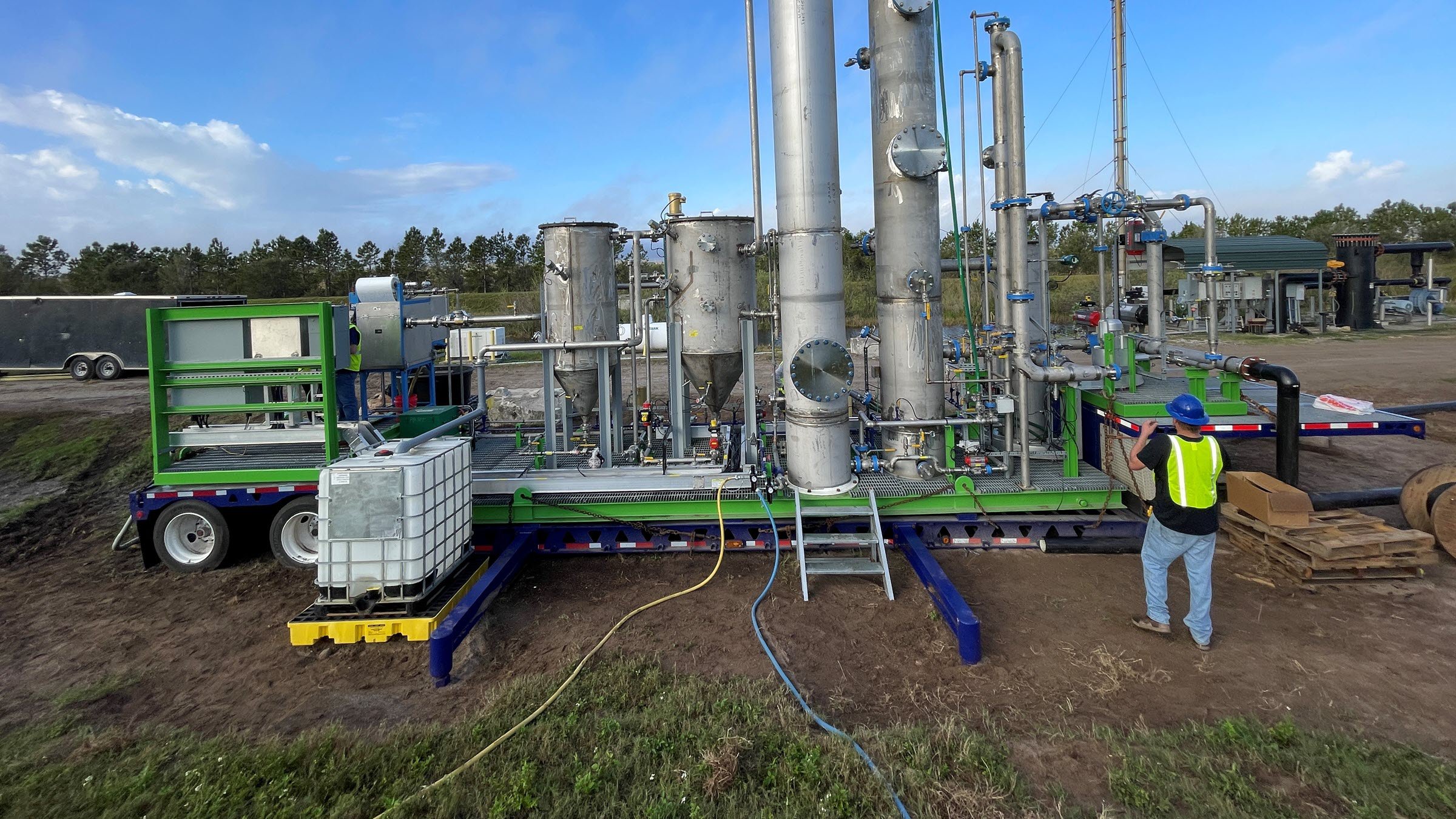Creative Chemistry Targets Renewable Energy
At first glance, landfills, dairy farms and pulp and paper mills appear to have little in common. But these divergent industries – along with wastewater treatment facilities – share a costly environmental challenge: managing significant volumes of organic waste.
Increasingly, these industries use anaerobic micro-organisms to initially break down or “digest” the waste. Biogas, primarily a mixture of methane, carbon dioxide (CO2), and hydrogen sulfide (H2S), is a by-product of that process. Biogas is potentially a valuable source of renewable natural gas (RNG). But to be used as a clean, safe fuel, it must first be treated to remove the CO2 and H2S.
“Thanks to government subsidies, more entities are upgrading biogas,” said Deane Little, CEO, New Sky Energy. “And removing the H2S from the gas stream is the critical first step in the process.”
Based in Boulder, Colorado, New Sky Energy develops innovative chemical solutions that help agricultural and industrial companies treat gas emissions, recover valuable chemicals – and convert raw biogas into renewable energy streams.
In 2018, the company made a truly game-changing discovery that led to the SulfurSolve® process – a transformational H2S capture system.
The SulfurSolve Difference
Hydrogen sulfide is foul smelling, flammable, toxic – and highly regulated. To remove H2S from a biogas stream, producers have typically relied on either single-use H2S chemical scavengers or regenerative H2S control technologies.
“Because you must constantly replenish the chemicals, the single-use scavenger method is very costly to operate,” Little said. “And in the end, you are left with a hazardous sulfide waste.”
The regenerative control technologies fall into two categories – biological and chemical. The biological methods are based on bacteria that use H2S as a resource to regenerate.
“But the biological methods are generally not very reliable – and we discovered that oftentimes, more chemicals must be added to these biological systems than we use in our chemical process,” Little said.
Chemical regenerative control technologies typically absorb H2S in an aqueous, iron salt solution. The solution is regenerated when exposed to air in an oxidation process. However, conventional chemical systems use costly organic chelating agents to achieve iron solubility.
“That’s where SulfurSolve is unique,” Little explained. “Our mixed metal ferric iron complex is inherently soluble in alkaline solutions. It does not require chelating chemicals to solubilize iron.”
From Pilot to Commercial Scale
According to Little, the chemical reaction that led to the SulfurSolve solution was unexpected.
“It was one of those ‘penicillin moments,’” Little explained. “We were experimenting with formulations and initially thought there had been some mistake when we produced the solution. Iron was not supposed to be soluble at these high pH levels.”
What followed was months of bench-scale testing in the lab to verify results. Next, the company spent a year testing pilot skids at wastewater plants, a pulp and paper mill, and a landfill.
After the successful pilots, New Sky Energy reached out to manufacturing partner Moore Control Systems to transition the system to commercial scale. An engineering, procurement and construction (EPC) company, Moore Control Systems has more than 40 years experience serving the oil and gas and other industries. The company is headquartered in Katy, Texas.
How It Works
Moore Control Systems designed a skidded SulfurSolve plant based on a Rockwell Automation control platform featuring Allen‑Bradley® CompactLogix™ controllers, PowerFlex® AC drives and a FactoryTalk® View HMI. The plant runs on an EtherNet/IP™ network.
Raw biogas entering the SulfurSolve plant is treated to remove droplets and solids and then exposed to SulfurSolve in low-pressure co- or counterflow contact columns. The alkaline SulfurSolve solution immediately captures and partially oxidizes the H2S. The partially spent solution with captured H2S is pumped to a regeneration vessel where exposure to air converts the captured sulfide to elemental sulfur and regenerates the SulfurSolve solution. Floating sulfur is recovered via pressure filtration. SulfurSolve solutions are regenerated and reused hundreds of times, significantly reducing H2S treatment costs.
“We’re helping customers integrate the SulfurSolve skid as the first step in the biogas upgrade process,” said Jessica Carollo, sales and marketing manager, Moore Control Systems. “We can also offer expertise with additional steps that complete the transformation to renewable natural gas, including CO2 removal and gas compression.”
Lower Operating Costs. Less Waste.
With many successful commercial implementations in the field, the SulfurSolve system is demonstrating impressive results. It consistently captures and removes more than 99.9% of inlet gas H2S – and recovers and reuses nearly 100% of the SulfurSolve solution.
New Sky Energy estimates the system reduces chemical purchasing and waste disposal costs for H2S control projects by up to 90% compared to systems using conventional chemical scavengers. Depending on application, typical return on investment (ROI) is 12-24 months.
“In addition, the elemental sulfur by-product can be sold and used as fertilizer or in other applications,” Little said.
SulfurSolve enables a more sustainable approach to H2S control for the biogas industry – and is also proving to be a viable option in other natural gas applications.
“Recently, we piloted the SulfurSolve system for amine tail gas treatment in natural gas processing,” Carollo said. “It did an incredible job and demonstrated SulfurSolve is applicable to these high flow applications.”
Learn more about our OEM solutions.
SulfurSolve is a registered trademark of New Sky Energy.

